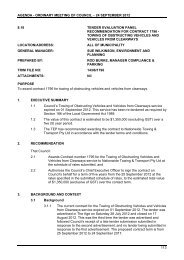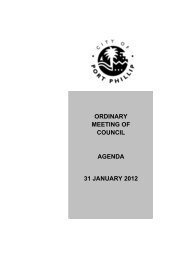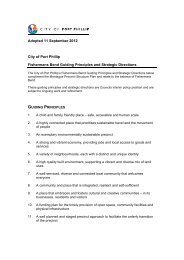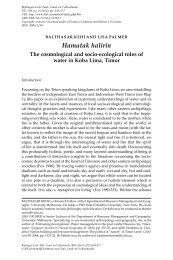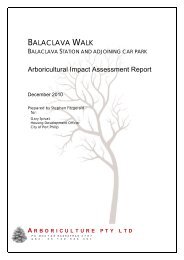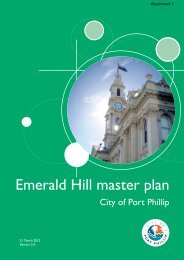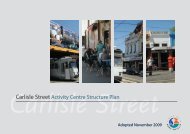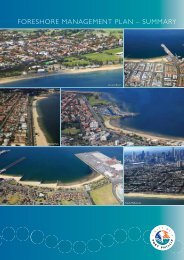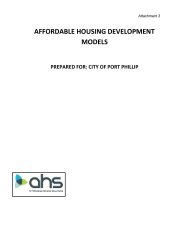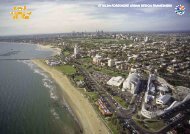Review of Heritage Overlay 1 Port Melbourne ... - City of Port Phillip
Review of Heritage Overlay 1 Port Melbourne ... - City of Port Phillip
Review of Heritage Overlay 1 Port Melbourne ... - City of Port Phillip
Create successful ePaper yourself
Turn your PDF publications into a flip-book with our unique Google optimized e-Paper software.
<strong>Port</strong> <strong>Phillip</strong> <strong>Heritage</strong> <strong>Review</strong>, Version 14, 2009 60<br />
Prepared for the <strong>City</strong> <strong>of</strong> <strong>Port</strong> <strong>Phillip</strong> by Andrew Ward, Architectural Historian<br />
6.2 <strong>Port</strong> <strong>Melbourne</strong> - H01<br />
Existing Designations:<br />
<strong>Heritage</strong> Council Register:<br />
National Estate Register:<br />
National Trust Register:<br />
nil<br />
nil<br />
nil<br />
Description: This Area is bounded on its north side by Ross Street and on the east by Ingles Street<br />
and Boundary Streets. Pickles Street marks the southern boundary which links directly with the<br />
South <strong>Melbourne</strong>, Albert Park, Middle Park and part St. Kilda Area. The western boundary is<br />
fragmented as a result <strong>of</strong> widespread recent residential redevelopment along the waterfront and<br />
inland. This redevelopment has in the past been undertaken by the public sector but in more recent<br />
times by the private sector. The fragmented nature <strong>of</strong> the western end is exaggerated by the Lagoon<br />
Reserve and associated recent residential developments. Also forming part <strong>of</strong> the <strong>Port</strong> <strong>Melbourne</strong><br />
Area are the residential areas physically linked with the Garden <strong>City</strong> estates but historically and in<br />
terms <strong>of</strong> their appearance more properly associated with this Area. These areas are generally located<br />
to the south-east <strong>of</strong> the earliest Garden <strong>City</strong> estates.<br />
The route <strong>of</strong> the former <strong>Port</strong> <strong>Melbourne</strong> railway line with its associated reserves and the Bay Street<br />
commercial thoroughfare divide <strong>Port</strong> <strong>Melbourne</strong> into discrete neighbourhoods. Their alignments<br />
relative to each other have resulted in the creation <strong>of</strong> a triangular shaped area bounded by Princes<br />
and Nott Streets that is in itself subdivided somewhat irregularly into street blocks and triangular<br />
reserves. The reserves are known as the Crichton reserve and the Sangster reserve and <strong>Port</strong><br />
<strong>Melbourne</strong> Bowling Club.<br />
The former railway route and gardens are overlooked by comparatively opulent houses in Evans and<br />
Station Streets. Verandahs are invariably built to the property line and there are some two storeyed<br />
Italianate residences at nos. 73 and 75 Evans Street and nos. 164 (“Ulster House”), 163 (“Derwent<br />
C<strong>of</strong>fey House”), 160-162 (“Alfred Terrace”) and elsewhere in Station Street. Although masonry<br />
construction predominates, there are also important timber cottages such as no. (63?) Station Street<br />
and 99-100 Evans Street. The house <strong>of</strong> the slaughterman, Caleb Kennett, at no.64 Evans Street is<br />
exceptional on account <strong>of</strong> its spacious garden, high bi-chromatic brick fence and palisade cast iron<br />
fence with cast iron pillars. These houses are more characteristic <strong>of</strong> the “better” streets <strong>of</strong> South<br />
<strong>Melbourne</strong> than <strong>of</strong> “<strong>Port</strong>” yet it might equally be argued that they constitute the “better” streets <strong>of</strong><br />
<strong>Port</strong> <strong>Melbourne</strong> as does the St. Vincent Place area, for example, constitute a “better” part <strong>of</strong> South<br />
<strong>Melbourne</strong>. Importantly, they represent a dimension to the fabric <strong>of</strong> the area <strong>of</strong>ten overlooked by<br />
persons unfamiliar with the place. They also demonstrate the importance <strong>of</strong> the railway gardens as a<br />
catalyst for substantial villa development last century. These gardens are noteworthy on account <strong>of</strong><br />
their exotic plantings. Some <strong>of</strong> the trees in the Turner and Walter reserves on Station Street and<br />
Evans Street respectively may have been planted as early as the turn <strong>of</strong> the century and are<br />
predominantly exotics. They include Cedrus deodara, Schinus molle var. areira, Ficus macrocarpa,<br />
Cupressus sempervirens, elms and a very large Ficus macrophylla in a fenced <strong>of</strong>f reserve in the<br />
centre <strong>of</strong> Raglan Street. The Gill, Howe and Smith reserves also include mature Schinus molle<br />
var.areira and Ficus macrophylla that collectively establish the highly distinguished ambience <strong>of</strong> the



